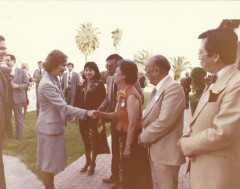Lifestyle Spotlight
Former First Lady Rosalynn Carter Passes Away at Age 96
Are you "Red Cross Ready" for a Disaster or Emergency?
Free Red Cross Online Tutorial Now Available at www.redcross.org/BeRedCrossReady to Help Families Get Prepared for a Disaster or an Emergency in Three Easy Steps
The month of June ushers in hurricane season, are you "Red Cross Ready" for a disaster or an emergency? According to an April 2007 poll conducted by the American Red Cross and Harris Interactive, only seven percent of the population has taken what the Red Cross considers the three steps necessary to prepare for a disaster or emergency: get a kit, make a plan, and be informed.
American Red Cross recommendations
(1) Families assemble or buy a disaster kit containing at least three days of supplies in an easy-to-carry container, like a backpack. Check that stock every six months and replace expired items.
(2) As part of your family plan, each person should know how to reach family members and where to meet if they can't go home.
(3) Families should learn about what types of disasters or emergencies are most likely to occur where they live, work and play, and take first air and CPR courses--a vital component of disaster preparedness.
"Even though hurricanes primarily affect coastal states, every region of our country is vulnerable to disasters of some type like flooding, severe storms, high winds, power outages, tornadoes, earthquakes, or wildfires," said Red Cross preparedness expert Darlene Sparks Washington. "Every family, no matter where they live, can benefit from following the preparedness actions of Be Red Cross Ready: get a kit, make a plan, and be informed."
"Preparing for a potential emergency or disaster doesn't require a lot of time or expensive equipment and training. In fact, to help Americans prepare the Red Cross has developed a free online tutorial," continued Washington. "To view the tutorial just visit www.redcross.org/BeRedCrossReady and in less than twenty minutes you'll learn exactly how you can become Red Cross Ready by getting a kit, making a plan, and becoming informed."
Results of the online survey conducted by Harris Interactive of more than 2,500 respondents during April 10-16, 2007 demonstrate that:
-90% of Americans who have a disaster kit feel prepared. Yet, only 28% actually have a kit.
-60% of American households own a pet, yet only 37% have a plan for their pets during a disaster.
-69% of Americans living in hurricane-prone states don't have a disaster supplies kit, and 60% don't have an evacuation plan.
-64% of Americans have no evacuation plan, even though 27% have had to leave home for at least one night because of a disaster or other emergency.
For more information, including downloadable resources, regarding how individuals and families can prepare for disasters visit www.redcross.org/BeRedCrossReady or contact your local Red Cross chapter.
Be Red Cross Ready products, like American Red Cross Emergency Preparedness kits and the American Red Cross Emergency Radio by Eton are convenient ways for families to get prepared for a potential disaster. Both products are available at the RedCross.org online store or at retailers near you. Emergency Preparedness Kits can be found at Target and Drugstore.com, and the American Red Cross radio is available at Amazon.com, Bed Bath & Beyond, Radio Shack and Hammacher Schlemmer.
The American Red Cross helps people prevent, prepare for and respond to emergencies. Last year, almost a million volunteers and 35,000 employees helped victims of almost 75,000 disasters; taught lifesaving skills to millions; and helped U.S. service members separated from their families stay connected. Almost 4 million people gave blood through the Red Cross, the largest U.S. supplier of blood and blood products. The American Red Cross is part of the International Red Cross and Red Crescent Movement. An average of 91 cents of every dollar the Red Cross spends is invested in humanitarian services and programs. The Red Cross is not a government agency; it relies on donations of time, money, and blood to do its work.
Source: U.S. ASIAN WIRE via BLACK PR WIRE


